




This walking tour covers a distance of approximately 3 miles in and around Edinburgh’s town centre. It takes in the homes of James Clerk Maxwell and some of his closest friends and relatives, his school, university and the churches he attended, and other points of interest along the way.
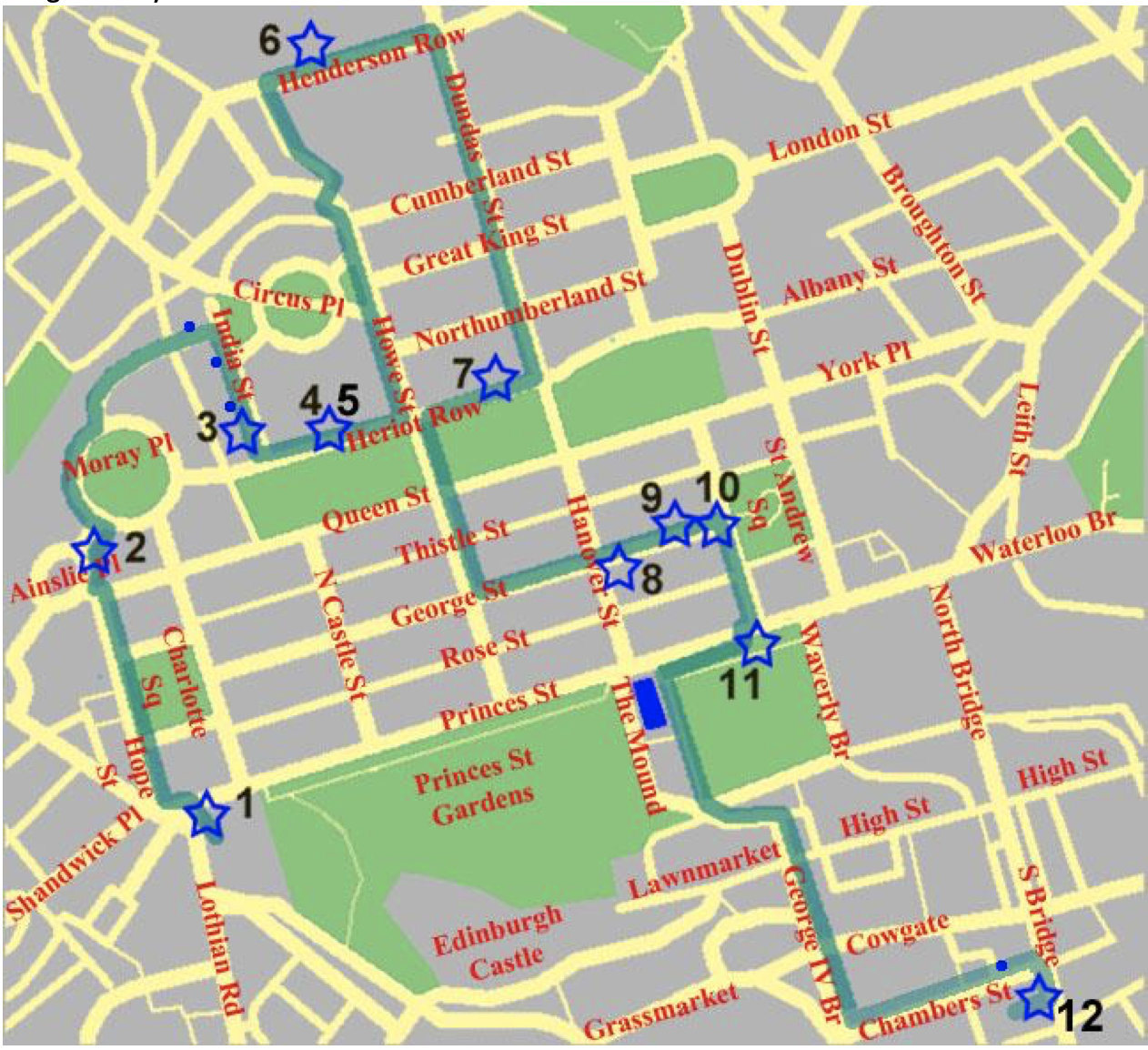
Starting at St John's Church at the junction of the western end of Princes St with Lothian Road, the route from stop to stop is given in the italicised paragraphs below. Generally, the main streets in this area of town either run more or less North-South or East-West. Please take care when crossing the streets, or stopping to admire the sights. The last part, from stops 5 to 11, is frequently uphill! The suggested route between stops 11 and 12 takes in the Playfair Steps, but these can be avoided by taking the offered alternative. Finally, world map co-ordinates are given under the heading for each location.
© JW Arthur 2013-16 (rev. 2021 JCMF)
@(55.950005,-3.206823)
Start at the Church entrance on Lothian Rd, at its junction with Princes St, opposite 'The Caledonian' (Waldorf Astoria Hotel).
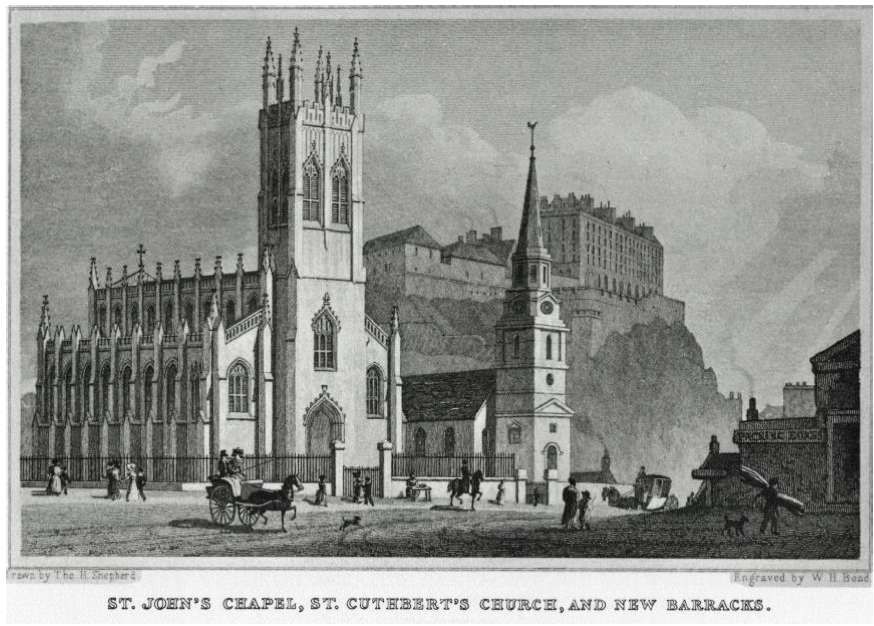
As schoolboy and student, James came to this church with his Aunt Jane Cay to attend Sunday afternoon service. Jane was the younger sister of his mother Frances Cay. Along with James's other close aunt, his father's sister Isabella Wedderburn, Aunt Jane helped bring up James after his mother died. The Cay family were much involved with this church, both as patrons and members of the congregation. James's parents were married here on 4th October 1826. Mary Chancellor, his great-grandmother; Alexander Irving, his great-uncle; his cousins Isabella Hay Mackenzie and Sir James Clerk, 7th Bt of Penicuik; and his friend, Peter Guthrie Tait, are all buried in the churchyard.
@(55.953677,-3.209569)
Cross to The Caledonian, then to N. side of Princes St, bear left, and then turn right onto Hope St. Cross to the W. side of Charlotte Square and proceed as far as St Colme St which runs EW. Cross to the N. side of St Colme St. and head left and soon round the corner, to the right, onto Ainslie Place. Proceed to the corner at number 25 Ainslie Pl., and number 6 Great Stuart St. is just around the corner. In fact, both addresses share the same site - 25 Ainslie Place being on the basement and ground floors, while 6 Great Stuart St. is above, on the 1st, 2nd and 3rd floors.

Aunt Jane Cay lived in a flat at 6 Great Stuart St. from 1832-54, part of that time with her brothers, Albert and Robert Dundas Cay. James often stayed with her when his Aunt Isabella Wedderburn, née Clerk, was out of town or indisposed. 25 Ainslie Place, on the other hand, was where Aunt Isabella lived in later years, (1861-65) with her son George and grandchildren Colin, Helen Louisa and Jean Charlotte Mackenzie. These last two grandchildren inherited 14 India St. on the death of James's wife, Katherine Dewar, in 1887. It is strange that these related families lived in different houses within the same grand edifice, but they were there at different times.
@(55.955283, -3.205654 )
Carry on along Great Stuart Street to the junction with Moray Pl. Go around Moray Pl. (clockwise is shorter) and exit just after 20 Moray Place, onto Doune Terrace. Carry on down Doune Terr., which then changes to Gloucester Pl. shortly before it meets India St. On the left at number 6 can be seen the house, now part of a hotel and restaurant, where Christopher North lived.
Christopher North was the pseudonym of John Wilson of Ellerey FRSE (1785-1854). An advocate and literary critic, he was a prolific writer for Blackwood's Magazine in which he had a 300 part series called Noctes Ambrosianae. Not only that, he was James Clerk Maxwell's Professor of Moral Philosophy at Edinburgh University.
Turn right onto India St. at the next junction, staying on its west side and passing numbers 38 and 18 along the way, unfortunately uphill, to number 14, near the top.
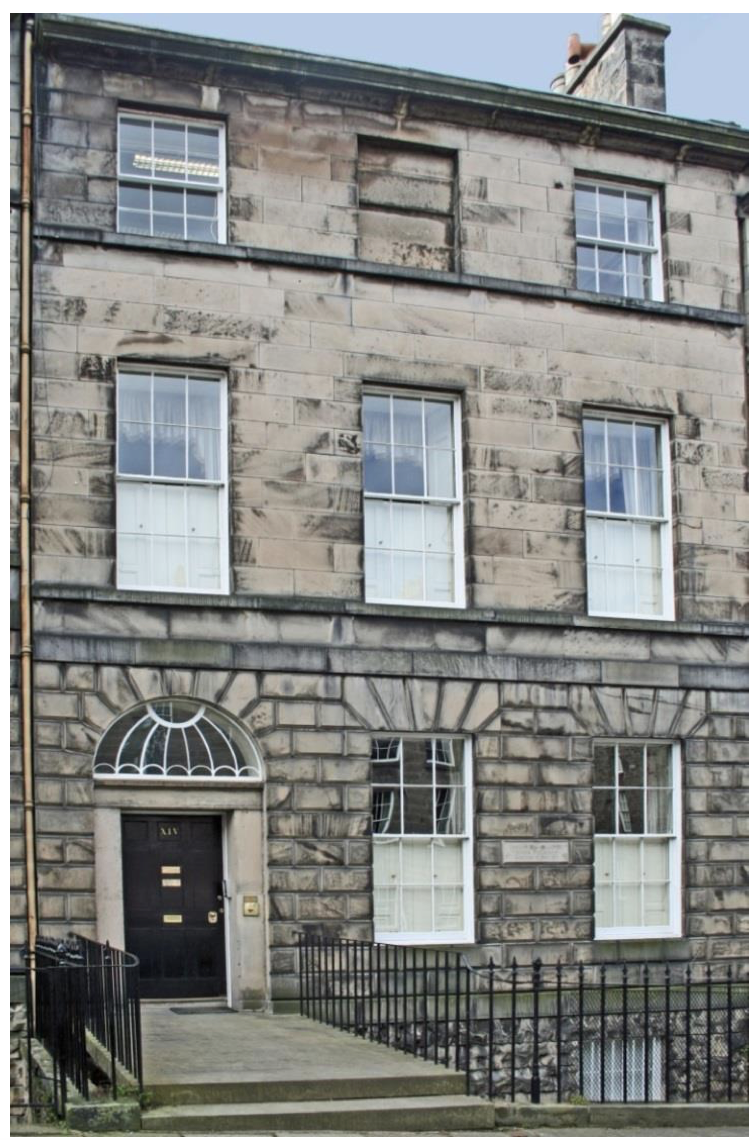
James's great-grandmother, Mary Chancellor, lived at 38 India St. from 1825-1828, while his Aunt Isabella lived at number 18 from 1851-60. James's birthplace at 14 India St. (above) now has a museum, home to the James Clerk Maxwell Foundation. The first occupants here were James's grandmother, Janet Irving, and some of her family. It was built for his father, John Clerk Maxwell, in 1820 when the building of Heriot Row was nearly finished and India St. was just beginning. In 1826, a few years after Janet Irving died, John Clerk Maxwell married Frances Cay. The couple then set up house here but also spent summer vacations at John's estate of Nether Corsock in Kirkcudbrightshire. By 1830 they had started to build a house there, which became known as Glenlair, and they began to live there, returning to 14 India St. only for the winter vacation.
In 1831 they stayed on in Edinburgh for the delivery of their son, James, born here on 13th June of that year. They used Glenlair as a summer residence until 1833, when James was two, when they moved there more or less permanently, staying mainly at 31 Heriot Row with James's aunt Isabella (see below) on their winter visits back to Edinburgh. Having been rented out as a valuable source of income, 14 India St was occupied over the years by a succession of tenants. The Clerk Maxwells never returned, and it was eventually sold by James's heirs at the end of the 19th century.
You are welcome to visit James Clerk Maxwell's birthplace at 14 India Street. Please see these details of real and virtual tours.
@(55.95519,-3.203499 )
From the house, cross the street and walk the short distance uphill to Heriot Row. Turn left onto Heriot Row and proceed to number 31.
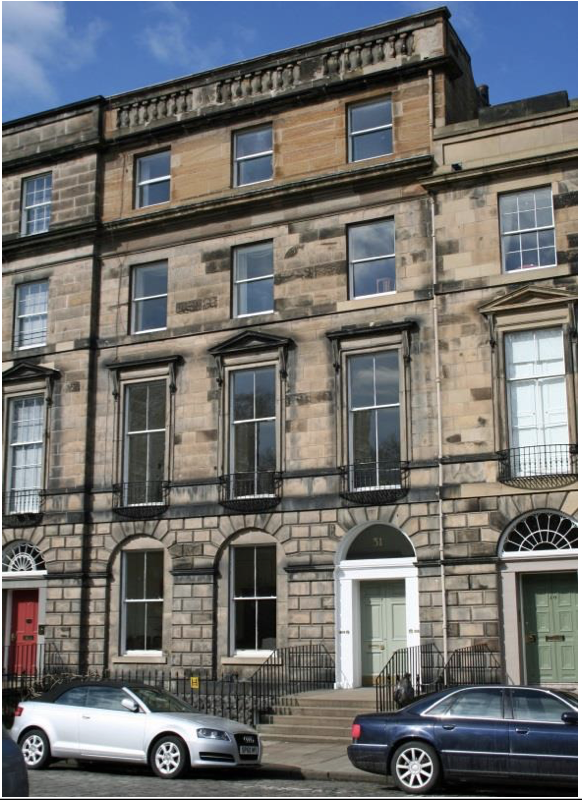
James lived with his Aunt Isabella at 31 Heriot Row during his schooldays and early university years in Edinburgh. James's cousins were a good bit older than him, but one of the youngest, Jemima, used to be a frequent companion, particularly during summer holidays at Glenlair. She recorded his early days at Glenlair and “Old 31”, as it was known, in watercolour sketches, some of which are on view at 14 India St. Jemima was born in this house in 1823, just a few months after the early death of her father, James Wedderburn, Solicitor General of Scotland. She married mathematics professor, Hugh Blackburn (her sister Jean married his brother Peter) and went on to become celebrated as a fine water colourist, particularly for her paintings of birds and flowers. Her brother Andrew Wedderburn, who was a civil servant with the East India Company, inherited Glenlair after James's death. In 1851, Aunt Isabella ‘flitted' round the corner to 18 India St., where James and his father would stay during vacations – just two doors down from their old home.
@(55.955279,-3.202939 )
Continue a few doors eastward along Heriot Row to number 27.

James's great-uncle, Alexander Irving of Newton, lived here from about 1806 when the house was built. In 1826 he was appointed as a judge and took the name Lord Newton. After his death in 1832, Alexander's widow, his cousin Bethinia Irving, stayed on until 1842. The next resident was Lt. Col. Hugh Morrieson, who married Mrs Constantia Campbell, a Welsh poet of some distinction. This lady was the mother of Lewis and Robert Campbell who, along with Peter Guthrie Tait, had become firm friends with James since meeting at school, the nearby Edinburgh Academy. In 1882 Lewis Campbell, along with William Garnett, published a comprehensive account of James's life and work.
@(55.96016, -3.204545 )
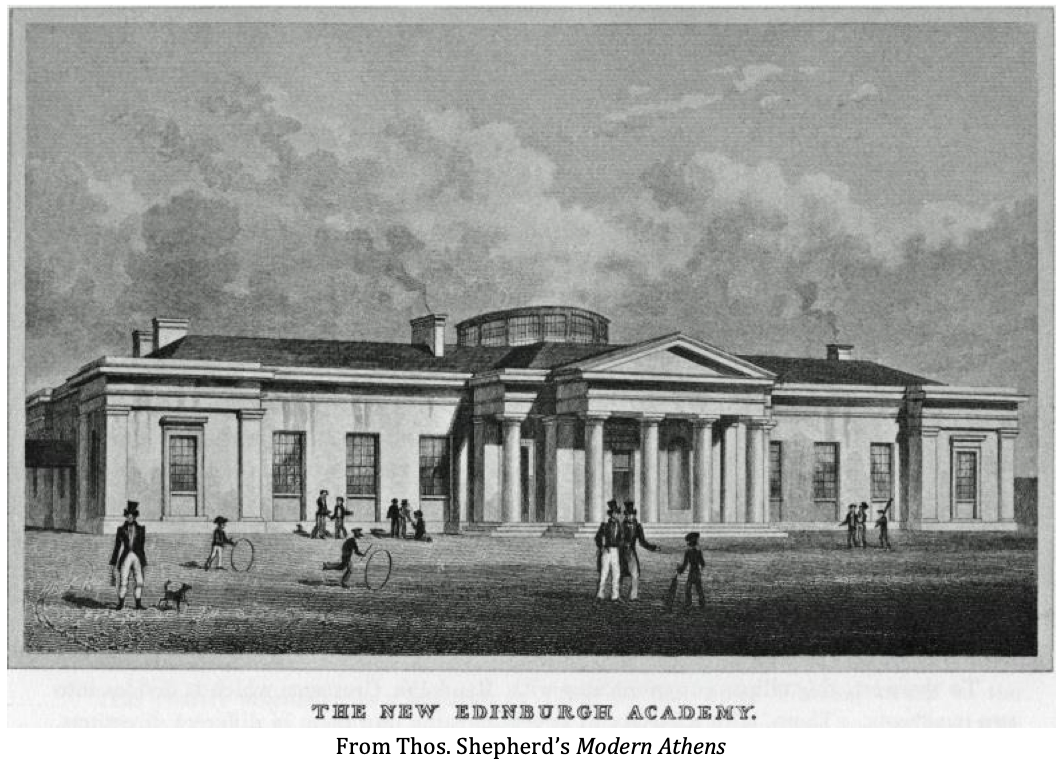
Proceed eastwards along Heriot Row to the next junction and turn left onto Howe St., which soon changes name to St Vincent St. Head downhill towards St Stephen's Church, then bear left a short way along St Stephen St. Turn right behind the church onto West Silvermills Lane, and follow it downhill onto Henderson Row. The entrance to the school is across the street, about 100m along on the right.
Edinburgh Academy opened as a school in 1824 with the object of providing the boys of the New Town with a strong classical education. Sir Walter Scott was among its first board of directors (see 11 below). Although Peter Guthrie Tait and James Clerk Maxwell took various prizes at school, it was Lewis Campbell who, by his mastery of the classics, became overall School Dux in 1847. He was later to become Professor of Classics at the University of St Andrews. In that same year, James won the Mathematical Medal and 2nd Academical Club Prize. Tait had been Class Dux in every year at school, but was never overall dux. Edinburgh's expanding and affluent New Town supplied the school with a great number of gifted pupils such as these. Inscriptions in both Latin and Greek are above the central portico: Latin: “Edinburgh Academy Dedicated to the Education of the Young. AD 1824” Greek: “Education is the Mother both of Wisdom and of Virtue” Although the original building remains very much the same, the school has added new buildings, one of which is the James Clerk Maxwell Science Centre (to the rear on the right).
@(55.955641,-3.200415)
Carry on eastwards along Henderson Row and turn right onto Dundas St. Head back uphill, passing Cumberland, Gt. King and Northumberland Streets, until you regain Heriot Row. Turn right and head westward back along the north side of Heriot Row until number 11 is reached.

Frances Cay, right, with her younger sister Jane Pastel by Elizabeth Cay, courtesy of the James Clerk Maxwell Foundation James's mother, Frances Cay, lived in this house before her marriage to John Clerk Maxwell. Her father, Robert Hodshon Cay, was a judge of the Admiralty Court; he brought his family to live here in 1804 when the house was just newly built. It was part of Edinburgh's second New Town, which was begun in 1800 and extended the Royalty of the burgh to the north of Queen St. Building in Heriot Row proceeded roughly from east to west, and it was more or less finished by 1810. However, access via Howe St, proper sanitation, and the construction of the Queen St. Gardens, were not completed for many years to come.
@(55.953619,-3.197043)
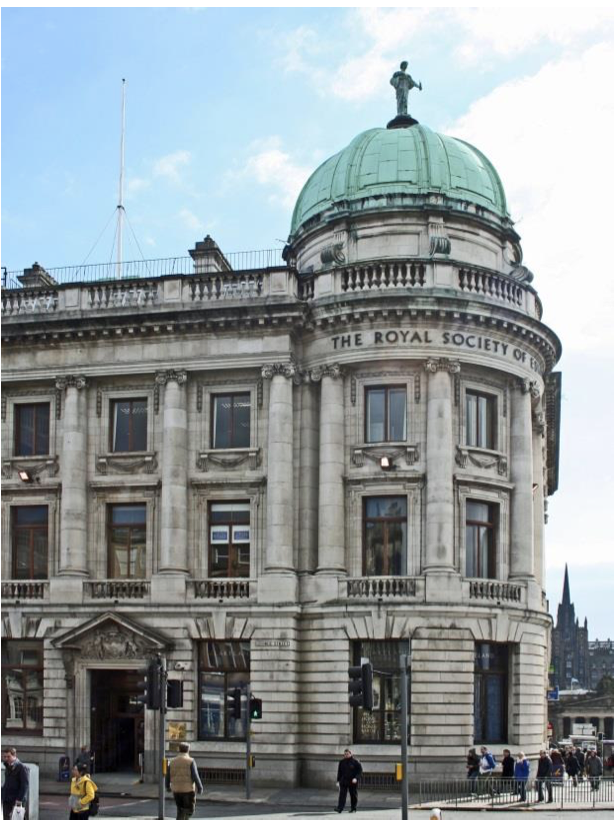
Continue westwards along Heriot Row, passing number 17, Robert Louis Stevenson's house, just before meeting Howe St. again, on the right, and Queen St. Gardens W., on the left. Go uphill on Queen St. Gardens. W., passing Queen St. and Thistle St., until George St. is reached. Turn left onto George St. and proceed eastward on its north side, crossing Hanover St. From there, the Royal Society of Edinburgh faces you from the other side of George St. (no need to cross over).
James's paper On Rolling Curves was presented to the Royal Society of Edinburgh (RSE) in February 1849 by his university tutor Prof. Philip Kelland. The home of the RSE was then the Royal Scottish Academy building, the colonnaded neoclassical frontage of which is prominently visible when looking down the length of Hanover St towards Princes St. James was four months short of his 18th birthday when this paper was read, but his paper On Oval Curves had already been read to the RSE by Prof. James Forbes when he was just 14, and still at school! James Clerk Maxwell was to become a Fellow of the RSE in 1856, at the age of just 24. His father and several other (male) members of his family were also Fellows. Women were only admitted as Fellows from 1949.
@(55.95384,-3.195759)
Continue eastward on the north side of George St for approximately 75m.
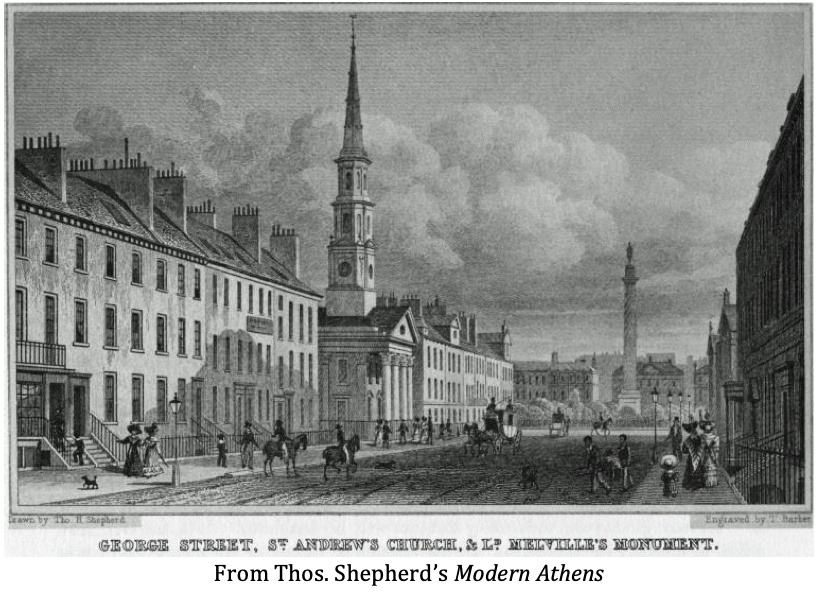
James Craig's New Town plan originally intended that St Andrew's Church, as it was then known, be built at the far side of St Andrew Square, at the place where an equestrian statue now stands. Laurence Dundas, by hoodwinking the City fathers, contrived to build an impressive mansion too close to where the church should have been. The city fathers simply had to swallow their pride and settle for this rather asymmetric location. When John Clerk Maxwell was in Edinburgh, St Andrew's was his regular church, and it was the church into which James was baptised on 29th July 1831. Twelve years later, during the annual General Assembly of the established Church of Scotland, it was the scene of the ‘Disruption' in which a large party of ministers seceded to form the ‘Free Kirk' in protest over the practice of landowner's patronage of the appointment of ministers.
@(55.954038,-3.194294)
Continue for a further 90m along the north side of George St. and cross to the statue.
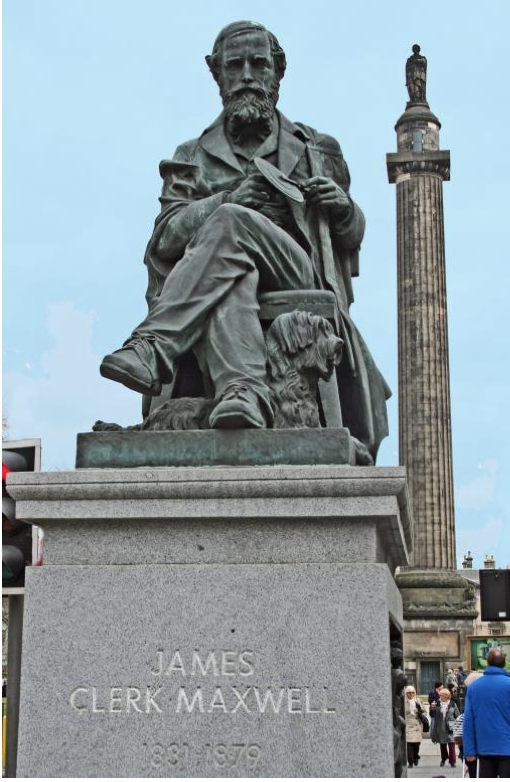
This statue by Alexander Stoddart, Sculptor in Ordinary to the Queen in Scotland, is the first and so far the only public monument to James Clerk Maxwell. It was erected by public subscription in 2008 at the instigation of Sir Michael Atiyah OM, then President of the Royal Society of Edinburgh, in an effort to improve recognition of one of the world's greatest ever scientists. It depicts James seated with his colour wheel in his hands and his terrier Toby at his feet, but his famous equations are a little out of the way, on the back of the plinth. As he wrestled with a new idea or tried a new experiment, James would frequently confide his thoughts to Toby for an opinion.
Facing the statue on the south side of the street used to be situated the entrance to 2 George St, the house where Frances Cay lived as a girl before her family moved to 11 Heriot Row. The building was demolished in 1937 to make way for the head office of the Caledonian Insurance Company, later becoming known as Guardian Royal Exchange. There is a large scale holographic image of the statue in the Royal Society of Edinburgh, and another in the James Clerk Maxwell Building of the University of Edinburgh.
@(55.952288,-3.193214)

Cross to the south side of George St. and follow the west side of St. Andrew Square towards Princes St., passing Rose St. The monument to Sir Walter Scott will be in full view. At Princes St., cross to the south side and enter the gardens to admire the monument.
Sir Walter Scott, advocate, renowned poet and romantic novelist, lived at 39 North Castle St, just on the other side of Queen St. Gardens from 14 India St. Scott was recruited by the founders of Edinburgh Academy (see stop 6 above) as a member of its first board of directors. He was a friend of several members of James's family, notably his grandfather Robert Hodshon Cay and several uncles. Scott was president of the Royal Society of Edinburgh from 1820 until the year of his death, 1832.
@(55.947516,-3.186376))
Head west along the path in the Gardens running parallel to Princes St. and exit onto the pedestrian square in front of the Royal Scottish Academy, formerly known as the Royal Institution. It was here, in 1846, that James Clerk Maxwell's first paper, On Oval Curves was read to the Royal Society of Edinburgh by Professor J D Forbes.
Turn left, passing the National Gallery, and head up the Playfair Steps. (An alternative route avoiding the many flights of steps is to go up the Mound via the far side of the two galleries). Keep going uphill, crossing Market St. and passing the Black Watch War Memorial.
Staying on the left, cross onto Bank St and reach the pedestrian crossing at the High St. Cross here and follow George IV Bridge, passing the National Library of Scotland on the left.
Take the first left into Chambers St., head down its gentle slope, keeping on the left side of the street with the National Museum of Scotland on the opposite side. At the corner on the east side of Guthrie St, you will find a plaque, at some height up on the wall, commemorating the site of the original house in College Wynd where Sir Walter Scott was born in 1771.
At the next junction (South Bridge), cross Chambers St. onto South Bridge and the entrance to the Old College Quadrangle will be found about 25m further along on the right.

James D Forbes was Professor of Natural Philosophy (physics) when James attended lectures here at the University. Forbes's lecture hall and apparatus store were located on the upper floor, by the three windows to the top left of the picture. They are now administrative offices. Having read James's paper On Oval Curves to the RSE in 1846, Professor Forbes was sufficiently impressed by his student to let him have free access to his laboratory equipment. Philip Kelland (who read Maxwell's On Rolling Curves) was the Professor of Mathematics, while William Hamilton (1788-1856) was Professor of Logic and Metaphysics. (Note that he was not the William Hamilton (1805-1865) who invented quaternions, used to model movement in 3D space, and enthusiastically promoted by Maxwell's lifelong friend, Peter Guthrie Tait.) These Professors, along with already mentioned Professor of Moral Philosophy, John Wilson, aka Christopher North, helped to give James a perspective that went well beyond purely scientific matters. The ‘Old College' replaced a ramshackle collection of buildings that were centuries old. The final design was by W H Playfair and, being built between 1817 and 1831, it was fairly new when Maxwell attended classes during 1847-1850. In the early 20th century, the Department of Natural Philosophy (physics) moved to a nearby building on Drummond St. which had previously been a surgical wing of the old Infirmary. It remained in that location until 1971, when, as the Department of Physics, it moved to a purpose-built new building at King's Buildings (the University's science campus to the south of the city). Appropriately, that 'new' building is called 'The James Clerk Maxwell Building', or the 'JCMB' for short.
Please Note: while many things on the route of the walk have survived for ages, others may well have changed by the time you do the walk. Neither the author nor the James Clerk Maxwell Foundation are liable for any errors, inaccuracies or omissions contained herein. Safety on the walk is entirely a matter for the individuals participating and no liability of any kind shall be accepted.
© JW Arthur 2013-16 (rev. 2021 JCMF)
JCM Foundation formed in Scotland in 1977.
Contact us.
Donations Welcome!
Privacy policy and cookies.